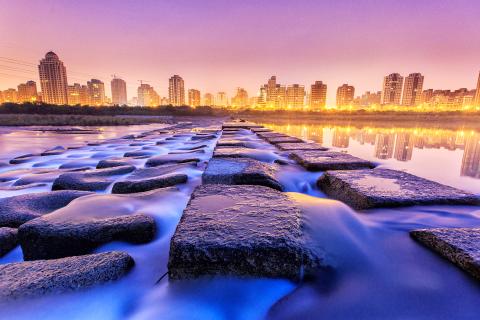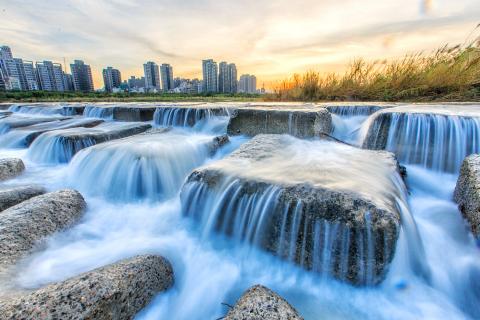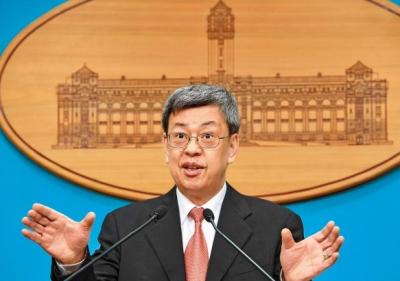Transformed by the red glint of dawn, the concrete wave breakers in the middle of Hsinchu County’s Toucian River (頭前溪) are a favorite subject for local photographers.
Nicknamed the “tofu rocks,” the wave breakers have also received some unwelcome attention, with media reports on April 7 saying that police were investigating a case of alleged illegal dumping of waste in a nearby dike.
Visitors who express disappointment at the “ordinary-looking concrete blocks” are missing the point of their attraction for photographers, Hsinchu resident and amateur photographer Lo Chun-pin (羅浚濱) said on Sunday.

Photo courtesy of amateur photographer Lo Chun-Pin
Beautiful pictures of the rocks posted on the Internet are usually the product of careful low shutter-speed camera work during specific light conditions, which create the effect of a white mist rising, he said.
The best views are achieved at dawn, which gives a pleasing red tint to the breakers, he said, adding that those images are known as hongshao (braised) tofu to photographers, in reference to their color.
The Water Resources Agency’s Second River Management Office said the breakers were placed to mitigate the erosion of the area’s riverbed and should not be considered a tourist attraction.

Photo courtesy of amateur photographer Lo Chun-Pin
“In fact, the breakers are located in a river reservation zone and trails leading to the area are slippery and dangerous following heavy rainfall. Members of the public who want to explore the area should be very careful,” it said.

Taiwan would welcome the return of Honduras as a diplomatic ally if its next president decides to make such a move, Minister of Foreign Affairs Lin Chia-lung (林佳龍) said yesterday. “Of course, we would welcome Honduras if they want to restore diplomatic ties with Taiwan after their elections,” Lin said at a meeting of the legislature’s Foreign Affairs and National Defense Committee, when asked to comment on statements made by two of the three Honduran presidential candidates during the presidential campaign in the Central American country. Taiwan is paying close attention to the region as a whole in the wake of a

Chinese Nationalist Party (KMT) Chairman Eric Chu (朱立倫), spokeswoman Yang Chih-yu (楊智伃) and Legislator Hsieh Lung-chieh (謝龍介) would be summoned by police for questioning for leading an illegal assembly on Thursday evening last week, Minister of the Interior Liu Shyh-fang (劉世芳) said today. The three KMT officials led an assembly outside the Taipei City Prosecutors’ Office, a restricted area where public assembly is not allowed, protesting the questioning of several KMT staff and searches of KMT headquarters and offices in a recall petition forgery case. Chu, Yang and Hsieh are all suspected of contravening the Assembly and Parade Act (集會遊行法) by holding

President William Lai (賴清德) has appointed former vice president Chen Chien-jen (陳建仁) to attend the late Pope Francis’ funeral at the Vatican City on Saturday on his behalf, the Ministry of Foreign Affairs said today. The Holy See announced Francis’ funeral would take place on Saturday at 10am in St Peter’s Square. The ministry expressed condolences over Francis’ passing and said that Chen would represent Taiwan at the funeral and offer condolences in person. Taiwan and the Vatican have a long-standing and close diplomatic relationship, the ministry said. Both sides agreed to have Chen represent Taiwan at the funeral, given his Catholic identity and

PRAISE: Japanese visitor Takashi Kubota said the Taiwanese temple architecture images showcased in the AI Art Gallery were the most impressive displays he saw Taiwan does not have an official pavilion at the World Expo in Osaka, Japan, because of its diplomatic predicament, but the government-backed Tech World pavilion is drawing interest with its unique recreations of works by Taiwanese artists. The pavilion features an artificial intelligence (AI)-based art gallery showcasing works of famous Taiwanese artists from the Japanese colonial period using innovative technologies. Among its main simulated displays are Eastern gouache paintings by Chen Chin (陳進), Lin Yu-shan (林玉山) and Kuo Hsueh-hu (郭雪湖), who were the three young Taiwanese painters selected for the East Asian Painting exhibition in 1927. Gouache is a water-based